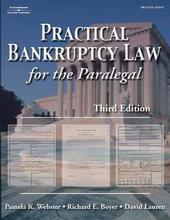
|
Practical Bankruptcy Law for Paralegals
Paperback
Main Details
| Title |
Practical Bankruptcy Law for Paralegals
|
| Authors and Contributors |
By (author) Pamela Webster
|
|
By (author) David Lauren
|
|
By (author) Ric Boyer
|
| Physical Properties |
| Format:Paperback | | Pages:512 | | Dimensions(mm): Height 276,Width 215 |
|
| Category/Genre | Organizational theory and behaviour |
|---|
| ISBN/Barcode |
9780766828568
|
| Classifications | Dewey:346.73078 |
|---|
| Audience | | General | | Undergraduate | | Professional & Vocational | | Postgraduate, Research & Scholarly | |
|---|
| Edition |
3rd edition
|
|
Publishing Details |
| Publisher |
Cengage Learning, Inc
|
| Imprint |
Delmar Cengage Learning
|
| Publication Date |
21 August 2003 |
| Publication Country |
United States
|
Description
Practical Bankruptcy Law for Paralegals is the textbook that meets all the needs of paralegal students exploring the topic of bankruptcy as it relates to their future profession. It presents this sometimes-complex subject in a straightforward manner. The text explores why bankruptcy law covers what it does, the written and unwritten rules of procedure that guide how the substantive law of bankruptcy is implemented and the necessary tools for mastering the procedural labyrinth of bankruptcy practice. Tools include timelines, checklists, analysis aids, sample forms and pleadings. The text addresses the issue of ethics and, in fact, addresses this subject at the end of each chapter in a feature called Ethics Pointer.
Author Biography
J.D., University of California, Davis
ReviewsChapter 1: Introduction. Chapter 2: The Bankruptcy Code and the Banruptcy Rules. Chapter 3: Role of the Paralegal in Bankruptcy Practice. Chapter 4: Building Blocks of Bankruptcy. Chapter 5: Bankruptcy Legal Research and Writing. Chapter 6: Bankruptcy Litigation and Appeals. Chapter 7: Beginning a Bankruptcy Case. Chapter 8: The Debtor's Perspective. Chapter 9: The Trustee"s Perspective. Chapter 10: Family Farmer and Individual Reorganizations. Chapter 11: Complex Reorganizations. Chapter 12: The Creditor's Perspective. Chapter 13: Taxes in Bankruptcy. Chapter 14: Electronic Filing.
|